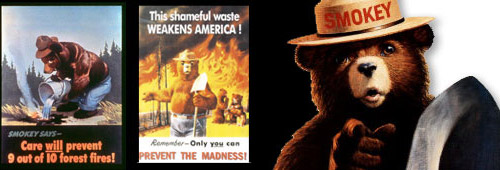Public Service Advertising
ADText: Advertising Curriculum
Unit 6: Public Service Advertising and Propaganda

The need to mobilize the public to take action for the good of the community is as old as governance itself. In other times and places, different techniques were used—rams’ horns, town criers, church bells, and even word of mouth. In modern times, the mass media provide an important vehicle for calling on citizens to act in their best interests and those of society. Many such messages are delivered as public service advertisements (PSAs). Smokey Bear warns about forest fires. Crime Dog McGruff asks us to “take a bite out of crime.” A Native American pleads with us to take care of the environment. What these—and other—public service campaigns have in common is that they use the techniques developed for the promotion of commercial products for a purpose other than selling products and services. The story of how that came about is an important part of the history of advertising in America.
1. The Beginnings of Public Service Advertising
Shortly after Congress declared war in 1917, President Woodrow Wilson established the Committee on Public Information which played a major role in convincing the public to support the war effort. George Creel, a Kansas City journalist whom Wilson appointed to chair the Committee, described its mission as coordinating “[n]ot propaganda as the Germans defined it, but propaganda in the true sense of the word, meaning the ‘propagation of faith.’”
With the help of people drawn from the advertising industry, the Committee created several major campaigns. Among them were:
• The War Savings Stamps drive that urged the public to “save the thoughtless dollars” that were being wasted through self-indulgence while soldiers sacrificed themselves on the battlefields of war.
• The Red Cross campaign that asked citizens to join the organization, which was personified in the ads in a Madonna-like image entitled the “Greatest Mother in the World.”
Continue reading Unit 6 >>
Revised 2012






